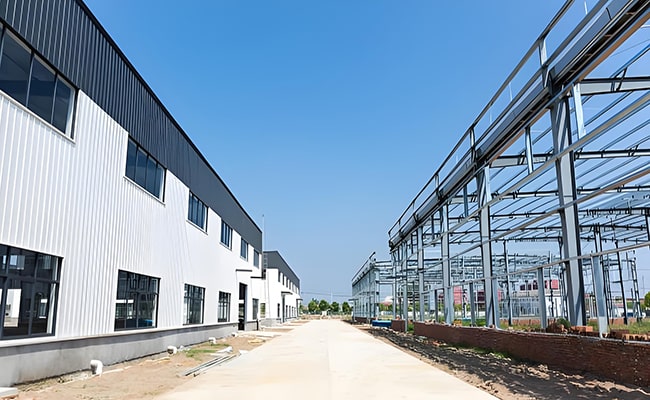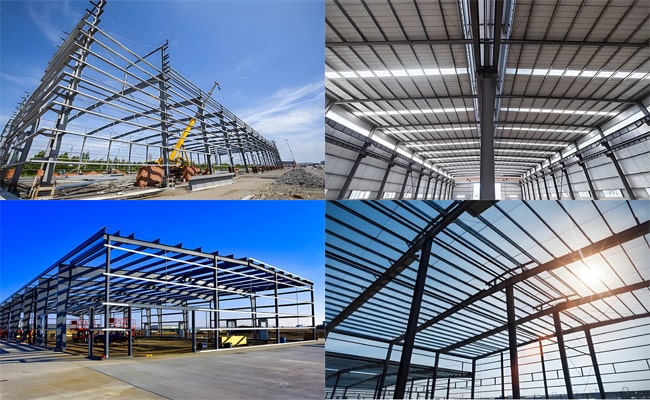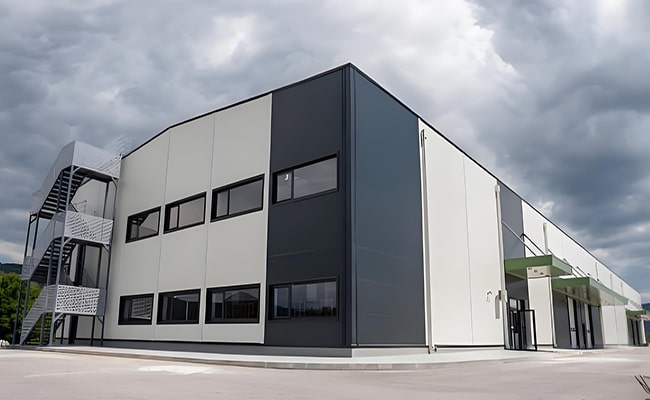Industrial workshop buildings serve as the backbone of contemporary manufacturing, housing processes that range from heavy-duty fabrication to precision assembly. Unlike conventional commercial structures, which often emphasize aesthetics or occupant comfort, these facilities are shaped predominantly by operational pragmatism. Their design emphasizes expansive, unobstructed interior volumes, adaptable spatial arrangements, and resilient infrastructure capable of accommodating machinery, labor, and logistics within a seamless workflow environment. At their core, industrial workshops are not static shelters but dynamic ecosystems that translate spatial intent into production efficacy.

Industrial workshop building design is far more than form—function made manifest. Spatial configuration directly influences throughput, safety, and overall workflow coherence. An intelligently planned layout minimizes redundant movement, shortens material travel paths, and integrates utilities in ways that amplify production fluency. Design decisions, when made in alignment with operational rhythms, can reduce energy waste, enhance employee well-being, and support long-term adaptability. Thus, architecture becomes an operational instrument rather than a passive backdrop.
Effective site planning begins with a thorough understanding of the land’s physical and geotechnical character. Topographical variations can inform drainage planning, access routes, and structural leveling strategies, while subsurface conditions—such as soil bearing capacity, stratification, and water tables—determine foundation design and long-term structural reliability. These early-stage assessments are not merely precautionary; they form the basis for every consequential design decision that follows.
Land use is governed by an intricate mesh of zoning ordinances, building codes, and environmental regulations. These legal frameworks delineate what is permissible—from building height and setback requirements to noise emission thresholds and waste management protocols. An informed reading of these constraints is not only essential for legal compliance but for securing community acceptance and operational longevity. Misalignment with regulatory expectations can delay or derail entire projects.
Industrial workshop building design for climate responsibility is not an ancillary concern—it is foundational to industrial performance and sustainability. In cold regions, snow loads and thermal bridging dictate roof pitch and envelope detailing; in tropical climates, ventilation, moisture control, and UV resistance become paramount. Material choices must respond to corrosion potential, thermal cycling, and solar exposure. The workshop building design ensures structural longevity and energy moderation by treating climate as a core parameter rather than an afterthought.

The internal organization of industrial workshop building design must accommodate divergent processes with varying environmental and spatial demands. Heavy machinery zones require vibration isolation and reinforced flooring, while areas devoted to fine assembly demand precision climate control and contaminant mitigation. Administrative functions and social spaces must be spatially buffered yet easily accessible. Functional zoning, when thoughtfully executed, enhances workflow clarity and ensures compliance with occupational safety standards.
Industrial productivity thrives on spatial efficiency. A coherent layout orchestrates the flow of materials, personnel, and equipment with minimal friction. Movement should be predominantly unidirectional, minimizing backtracking and congestion. Visual transparency, clear demarcation of paths, and the strategic placement of access points further enhance navigability. This spatial choreography transforms floor plans into kinetic systems aligned with production logic.
Industrial workshops require more than manufacturing space—they need a constellation of support functions that sustain operations. Maintenance areas, technical storage, sanitation facilities, and safety stations must be embedded within the layout in ways that preserve workflow yet ensure the immediacy of access. These ancillary zones, while often overlooked, are pivotal to maintaining continuity in high-demand production settings.

The decision between steel and concrete frameworks is contingent on multiple vectors: load behavior, climatic exposure, erection speed, and future adaptability. Steel excels in spanning large distances, allows for faster construction, and supports modular retrofitting. Concrete, conversely, offers thermal inertia, mass dampening, and enhanced fire resistance. The selection is rarely binary; hybrid systems often achieve optimal performance by marrying the tensile strength of steel with the compressive robustness of concrete.
Industrial workshop building design for load-bearing must accommodate not only dead loads and live operational forces but also transient stresses arising from equipment movement and environmental factors. Structural redundancy—achieved through backup load paths, oversized members, or dual bracing systems—ensures that localized failure does not precipitate systemic collapse. In mission-critical facilities, redundancy is a precondition for resilience.
Seismic and wind resistance are no longer optional; they are essential components of responsible structural design. In seismic zones, base isolation systems, ductile connections, and moment-resisting frames reduce risk. In hurricane-prone regions, aerodynamic profiling and lateral bracing systems mitigate wind uplift and torsion. These strategies are not add-ons but embedded layers of protection that sustain safety and operational continuity.

A high-performance building envelope moderates internal temperatures, stabilizes humidity levels, and reduces energy costs. Advanced insulation systems—such as sandwich panels or closed-cell foams—prevent heat exchange and condensation. In industrial contexts, where process stability and worker comfort are intertwined, thermal performance becomes a technical and economic imperative rather than a mere architectural concern.
Cladding serves dual purposes: environmental shielding and visual articulation. Options range from galvanized steel panels and fiber-cement boards to high-pressure laminates and polycarbonate assemblies. The choice of cladding must balance aesthetic considerations with resistance to UV radiation, impact, corrosion, and thermal cycling. Additionally, cladding systems can be integrated with passive ventilation channels or photovoltaic modules, aligning with sustainability goals.
The industrial workshop building design for the roof extends far beyond shelter. Effective drainage systems—comprising gutters, scuppers, and internal downspouts—prevent water accumulation and structural degradation. Skylights or translucent roof panels introduce natural daylight, improving visual comfort and reducing dependency on artificial lighting. Meanwhile, roofs must also withstand mechanical loads from HVAC systems, snow, or future solar installations. A well-conceived roof is a convergence of engineering rigor and environmental responsiveness.

Steel has become a preferred material in modern industrial workshop buildings due to its high tensile strength and remarkable ductility. Nonetheless, its pronounced thermal conductivity renders it inherently vulnerable under elevated temperatures. As ambient heat levels exceed 100°C, the material’s tensile strength begins to deteriorate. While moderate cooling initially enhances its plasticity, this benefit wanes as temperatures approach 250°C. Beyond this threshold, the structural integrity of steel rapidly diminishes, and by 500°C, it becomes critically brittle—prone to sudden fracture without significant deformation. In contrast to concrete, which offers superior heat resistance and insulation, steel’s thermal fragility underscores the urgency of integrating robust fireproofing measures in industrial design.
Effective fire safety in steel workshop buildings must be tailored to the facility’s functional characteristics and risk profile. This requires a nuanced interpretation of process flow diagrams, manufacturing procedures, and heat-generating operations. Compliance with national and international fire protection standards is non-negotiable during the design phase. Material selection should prioritize both structural performance and certified fire resistance. The application of intumescent coatings—specialized fire-retardant paints that swell upon heating—serves as a frontline defense. These coatings form an insulating carbonaceous layer that significantly delays heat penetration, buying critical time in the event of fire exposure.
Beyond passive fireproofing, the architectural layout of the workshop must be deliberately configured to mitigate thermal hazards. This involves the systematic placement of firewalls, thermal barriers, and designated escape routes that comply with regulatory egress standards. Fire escape stairwells should be positioned to ensure safe and swift evacuation from any point within the facility. In zones with high radiant heat—particularly those adjacent to furnaces or thermal treatment equipment—steel elements must be enveloped in heat-resistant cladding or insulation materials specifically engineered to withstand prolonged thermal stress. A comprehensive fire and thermal protection framework not only preserves the integrity of the structure but also safeguards human life and operational continuity in high-risk industrial settings.
The increasing incidence of earthquakes in recent years has brought renewed urgency to the seismic design of industrial workshops. Rather than treating seismic considerations as supplementary, they must be integrated as a core component of the structural planning process. Ensuring not only life safety but also the structural continuity and functional reliability of facilities during and after seismic events requires early and sustained attention to earthquake resilience throughout the design lifecycle.
Effective seismic design begins with a holistic structural strategy that aligns with the functional and spatial requirements of industrial production. Engineers must interpret detailed process layouts in conjunction with structural demands, ensuring that load paths are continuous and robust. Central to this approach is the horizontal structural system, which serves as the primary mechanism for lateral force resistance. Its configuration—through the deployment of bracing systems, diaphragms, and shear-resisting elements—determines how seismic energy is absorbed, distributed, and ultimately dissipated within the structure. A well-conceived horizontal system is not merely a structural necessity but a critical safeguard against dynamic instability.
The seismic performance of an industrial workshop ultimately depends on how individual structural components behave under cyclic loading. A nuanced understanding of the interaction between materials and dynamic forces is essential. Designers must account for ductility, stiffness degradation, and energy dissipation capacity in both the global structure and local connections. Special emphasis should be placed on the integrity of joints, as these are often the first points of failure under seismic stress. Furthermore, site-specific factors—such as soil conditions, seismic zoning, and the presence of nearby fault lines—must be systematically analyzed to inform structural frame selection. Meticulous detailing at the nodal level, including reinforcements that enhance tensile capacity and prevent brittle failure, plays a pivotal role in ensuring that the structure not only survives a seismic event but also remains functional thereafter.
In the context of global efforts toward sustainable development, energy efficiency has emerged as a central concern not only in residential and commercial construction but increasingly within the industrial sector. As awareness grows regarding the environmental and economic implications of energy consumption, industrial buildings are being held to progressively higher performance standards. This shift is driven not only by regulatory changes but also by rapid advancements in building technologies, which together promise to elevate the energy performance of industrial workshops in both new construction and retrofitting projects.
The German EnEv2007 standard serves as a salient reference for how energy performance can be systematically optimized through intelligent control systems. Central to this approach is the use of simulation-based software, which models energy consumption patterns, integrates supplementary renewable sources, and guides the development of building-wide energy strategies. These systems rely on complex algorithms that adjust operational parameters in real time, aiming to achieve a dynamic equilibrium between energy demand and supply. However, the effectiveness of such systems is heavily contingent upon the availability of accurate baseline data and the consistency of the certification and algorithmic standards across projects. Although this model has found more extensive application in residential settings and technologically advanced commercial developments, it is expected to gain greater traction in industrial contexts, particularly as the demand for data-driven energy solutions increases.
Beyond intelligent control systems, substantial energy savings can be achieved through passive design strategies and optimized systems integration during the architectural planning phase. Maximizing natural daylighting, employing high-performance insulation and reflective materials, and incorporating convection-enhanced ventilation pathways are all effective means of reducing reliance on mechanical energy inputs. Similarly, careful design of water supply and drainage infrastructure can contribute to overall resource efficiency. Importantly, many of these interventions can be implemented without significant operational disruption, especially in new builds. Additionally, integrating closed-loop recycling systems and capturing residual thermal energy within workshop operations further reinforces sustainability objectives. These approaches underscore the potential for industrial architecture to move beyond compliance and toward a genuinely energy-conscious design paradigm.
Industrial workshop building design is a synthesis of engineering logic, environmental sensitivity, and operational intelligence. It is not merely a matter of enclosing space but of constructing a high-functioning, adaptable, and resilient framework that supports complex industrial processes. Every design decision—from site selection to cladding choice—carries long-term implications for performance, safety, and sustainability. Through careful planning and context-specific solutions, industrial workshops evolve from static shelters into dynamic engines of production.